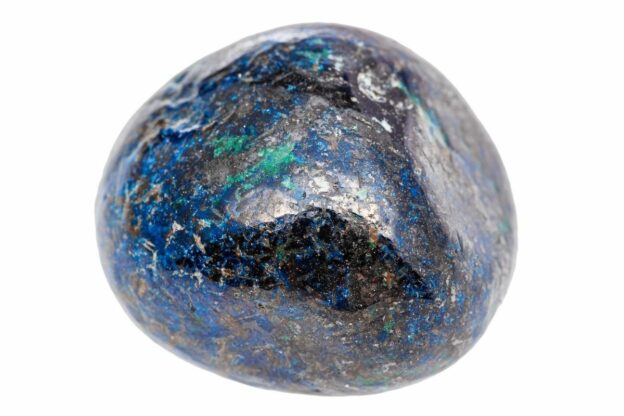Azurite (from French “azur”) – azure, (from Persian “lazard”) – blue. According to ancient descriptions, azurite was often confused with dark blue lapis lazuli, which was highly prized in the East. The words azurite and lapis lazuli come from the same Arabic root “azul” – blue, and the Persian “lazard” – azure, where the initial “l” is just an article. This stone is also called copper azure and mountain blue. In Europe, azurite was called Shessilite, because it was mined in the French town of Chessy.
Origin and chemical composition
Azurite is a copper ore that is less common in nature than lapis lazuli but is less valuable in the industry. The mineral is formed in deposits with a high content of copper sulphites as a result of their oxidation. Basically, nuggets have a cryptocrystalline form, natural stone crystals are very rare. Azurite often forms pseudomorphs with malachite. This breed is called Azur-malachite. In terms of chemical composition, azurite is aqueous copper carbonate.
Price
The average price for azurite cabochons on the market is $ 3-7 per gram. Given the complexity of processing, the cost is significantly affected by the size of the stone – the larger it is, the more expensive it is. Azurites from Zaire are considered to be of the highest quality, where large nuggets can often be found.
Physicochemical properties of azurite
- Chemical formula – Cu3 (CO3) 2 (OH) 2.
- Color – light blue, blue, purple.
- The system is monoclinic.
- Hardness – 4 on the Mohs scale.
- Density – 3.5-4 g per cm3.
- The fracture is conchial.
Processing and use
Jewellery with azurite inserts is practically not found on the market, which is due to the increased fragility of the stone (cracks even with a slight mechanical effect) and unstable color. Azurite is primarily of interest to mineral collectors. Small azurite cabochons, due to their affordable price and the characteristic color, often become the first exhibits in the collections of aspiring collectors. Less often they are used as an ornamental material. In the jewellery industry, azur-malachite has found application, devoid of the shortcomings of pure azurite, but no less beautiful.
Azurite deposits
Azurites are mainly mined in Australia (Queensland), Chile, Mexico, USA (Arizona and New Mexico), Germany, France, Kazakhstan and Africa (Zaire, Namibia, Zambia). In terms of the quality of collectable azurite, the first place belongs to the famous Teumeb deposit in Namibia, where individual crystals reach 25 cm in size with impeccable quality. Azurites from deposits in Morocco – Mibladen and Tuissit are widely known. Interesting samples of azurite are mined at the copper deposits of the South Urals.
Imitation and synthetics
Today, as in the old days, azurite is often confused with its counterpart lapis lazuli, considering azurite to be only one of the varieties of the latter. Azurite is a completely independent mineral, which, in contrast to lapis lazuli, has a much brighter blue tone. Malachite stains are not observed in lapis lazuli, while azurite often fuses with malachite. Azurite is easy to distinguish from other stones, as it is the only mineral with a deep blue color that boils in hydrochloric acid.
The magical properties of azurite
In ancient Egypt, priests used azurite to communicate with the gods. In Ireland, the druids, with the help of native azurite sticks, helped the youth decide on the choice of life. Azurite is useful for those who are engaged in energy practices, fortune-telling and prediction. Occultists and mediums use azurite balls and crystals to meditate and enter an altered state of consciousness.
In the East, it is the “third eye” stone. According to the famous specialist in minerals Katrin Raphael, azurite products will help get rid of negative emotions, overcome fears, and relieve emotional arousal. If you are having a difficult period in your life and you cannot make the right decision, put on jewellery with azurite, and this stone will show you the best way to solve the problem.
As a talisman, azurite is suitable for people who, due to their duty, must be honest and objective – lawyers, judges, journalists, but only on the condition that the owner does not disassemble, otherwise, the stone may punish him.

